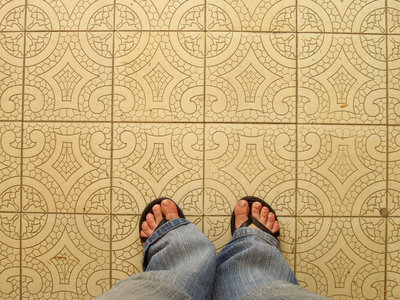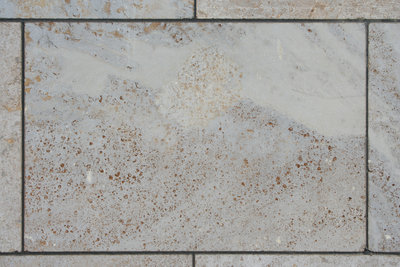Homeowner How To: Selecting Tile for your Renovation
 Porcelain, ceramic, natural stone, glass, metal, mosaics, there are so many choices to make when you are remodeling your home that involve selecting tile. Tile can be used as flooring in a kitchen, foyer, laundry area, mudroom and bathroom, as well as many outdoor areas. Selecting the right tile means the difference between mediocre and brilliant design. What is the difference between ceramic, glazed and porcelain tile? When and where should glass and natural stone tiles be used?
Porcelain, ceramic, natural stone, glass, metal, mosaics, there are so many choices to make when you are remodeling your home that involve selecting tile. Tile can be used as flooring in a kitchen, foyer, laundry area, mudroom and bathroom, as well as many outdoor areas. Selecting the right tile means the difference between mediocre and brilliant design. What is the difference between ceramic, glazed and porcelain tile? When and where should glass and natural stone tiles be used?
Here is the inside scoop on selecting tile for your home...
How tile is made: Tile is made by either pouring the base materials into a mold, and then exposing those to high heat ovens, or shaping and cutting stone. It can be hand painted, hand poured, glazed with a shiny coating like you may have done in a ceramics class, or it can be made of the same color material all the way through. Small pieces of ceramic, porcelain, stone, tile and glass can be made into intricate mosaics by hand or by cut to size by an advanced computer program. Mosaics can be made of numerous materials including metals, wood, marble, granite, ceramic and porcelain.
Glazed tile: Less expensive than porcelain, glass and natural stone, glazed ceramic tile is the go to product for builders and is used extensively in residential homes as well as commercial buildings. A layer of colored glaze coats a ceramic base below. These versatile, lightweight, durable tiles are great for walls in bathrooms or for tile backsplashes…and generally textured versions of this are used as floor tile. Mix and match with the huge variety of colors and sizes…you can really play with layouts with this product as there are infinite colors and shapes available to choose from. This type of tile can be pretty inexpensive in general. Some glazed tiles are handmade and imported so not all will be inexpensive and some will be more durable than others. Glazed ceramic tile should not be used in high traffic floor areas and the shiny versions are not advisable for floors, especially wet floor areas or areas where frost/freezing may occur. Over time the glaze can start to wear and extreme tempature changes can lead to cracking and damages. If the tile cracks or is chipped you will see the white or terracotta colored ceramic show through from underneath.
 Porcelain tile: Porcelain tile can also refer to glazed tile. But most porcelain tiles are not glazed and are generally much more dense than a glazed tile. Through-color porcelain tile means that the color runs throughout the thickness of the tile. Porcelain is a much more dense, durable, heavy and solid material and is much less porous than ceramic. Generally, it can stand up to high and low heat, exterior conditions, wet areas and high traffic floors. Some can even hold up to extreme temperatures and frost without cracking or damage. It is very popular to use this type of tile in main flooring areas, commercial applications, exterior areas, front entryways and kitchens and bathrooms. It can be a little more expensive depending on the color and manufacturer, but it is a long term choice and will look good, even with minor chips, for the long haul. If a piece does get chipped, the color below is the same as the color on top, so it is generally not noticeable.
Porcelain tile: Porcelain tile can also refer to glazed tile. But most porcelain tiles are not glazed and are generally much more dense than a glazed tile. Through-color porcelain tile means that the color runs throughout the thickness of the tile. Porcelain is a much more dense, durable, heavy and solid material and is much less porous than ceramic. Generally, it can stand up to high and low heat, exterior conditions, wet areas and high traffic floors. Some can even hold up to extreme temperatures and frost without cracking or damage. It is very popular to use this type of tile in main flooring areas, commercial applications, exterior areas, front entryways and kitchens and bathrooms. It can be a little more expensive depending on the color and manufacturer, but it is a long term choice and will look good, even with minor chips, for the long haul. If a piece does get chipped, the color below is the same as the color on top, so it is generally not noticeable.
Glass tile: There are a wide array of glass tile products on the market, from subway tiles to mosaics in numerous colors and styles. These can have a smooth, shiny finish or a matte finish and be a single color with a transparent look, or they can be woven with shiny veins of shimmers and colors to create an exotic look. Some glass tile can be rather thin in relation to other tiles, so be sure to see how it measures compared to other tile you may be using alongside it. Glass tile is rather delicate, especially before it is installed, so be sure to thoroughly inspect it prior to installing. Once it is properly installed, it is highly durable when installed in appropriate applications. It is popular to use glass tile for kitchen backsplashes, on walls, in bathrooms as an accent or wall tile, or with discretion as a small accent in flooring. Generally, glass tiles are not used as flooring on their own. Glass tile is available in every color of the rainbow and in numerous sizes and styles. It can range in price from reasonable to very expensive. In a mosaic, it can be paired up with ceramics and marble in varied sizes and is used most often for backsplashes in kitchens or bars.
 Marble and Granite tile: Marble or granite tile are simply pieces of natural stone that are cut into a variety of standard tile sizes. These tiles are generally more expensive than ceramic based tiles, and can vary from a larger flooring size to a small subway tile, or can be made into sheets of mosaics. Marble must be sealed regularly to avoid staining and can be slippery when used in wet areas.
Marble and Granite tile: Marble or granite tile are simply pieces of natural stone that are cut into a variety of standard tile sizes. These tiles are generally more expensive than ceramic based tiles, and can vary from a larger flooring size to a small subway tile, or can be made into sheets of mosaics. Marble must be sealed regularly to avoid staining and can be slippery when used in wet areas.
Terrazzo tile: Terrazzo is made from a mixture of glass and concrete cut into tile sizes and heated under high temperatures. It is very popular in large commercial projects and as flooring. It is generally very durable and expensive, comes in very large tile sizes and is very heavy. Glass and concrete can be tinted to almost any color, so terrazzo can be very colorful and is available in numerous tones. Concrete is very porous, so it must be sealed regularly. But even after years of abuse, it can be ground down and resealed to look like new, so all in all, it is a very "green" product.
If you are using tile in a large area of your home it is very important to keep a few boxes of "attic stock" on hand in case a portion of the tile becomes damaged, needs to be changed, or there are renovations that require patching in new areas. The tile you purchased is sold in lots which are identical, but that lot is unique and will never be available or made again. By the time you’ve purchased your tile, the original mold that was used to fabricate your tile is long gone. So always be sure to set aside at least 10% or a minimum of 1-2 boxes of additional tile from the same lot.
If you are unsure about which type of tile, or color tile is right for your project, you may want to consult with a kitchen and bath designer or interior designer. Their knowledge and expertise will assist you in carefully selecting the right product the first time and result in a beautiful space you will enjoy for many years to come. The cost of a designer will save you hours of time in deciding and choosing or possibly from having to do the entire job over if the wrong colors or products are selected.
Smart design will save you time and money! Choose wisely. Hire a professional.
